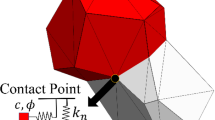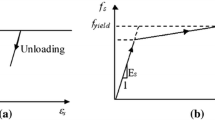Abstract
In this work, we aim to tackle one of the most devastating failure modes in reinforced concrete (RC) structures: the diagonal-tension failure. In order to study this phenomenon numerically, a model capable of dealing with both static and dynamic crack propagation as well as the natural transition of these two regimes is necessary. We chose a discrete cohesive model for concrete fracture, an interface bond-slip model for the deterioration between concrete and steel rebar, both combined with an insertion algorithm. The static process is solved by a dynamic relaxation (DR) method together with a modified technique to enhance the convergence rate. The same DR method is used to detect a dynamic process and switch to a dynamic calculation. The methodology is applied to model the experimental results of Carmona et al. (Engineering Fracture Mechanics 74:2788–2809, 2007), where the recognition of the transition to a dynamic fracture in a presumably static calculation is essential to reproduce the diagonal-tension failure observed.
Similar content being viewed by others
References
Ahmad SH, Hizo S, Chung W, Xie Y (1995) An experimental technique for obtaining controlled diagonal tension failure of shear critical reinforced concrete beams. Mater Struct 28: 8–15
Bažant ZP, Yu Q (2005) Designing against size effect on shear strength of reinforced concrete beams without stirrups: I, Formulation. J Struct Eng ASCE 131(12): 1877–1885
Bažant ZP, Yu Q (2005) Designing against size effect on shear strength of reinforced concrete beams without stirrups: II, Verification and calibration. J Struct Eng ASCE 131(12): 1886–1897
Carmona JR, Ruiz G, del Viso JR (2007) Mixed-mode crack propagation through reinforced concrete. Eng Fract Mech 74: 2788–2809
Carpinteri A, Carmona JR, Ventura G (2007) Propagation of flexural and shear cracks through reinforced concrete beams by the bridged crack model. Magaz Concrete Res 59(10): 743–756
Collins MP, Kuchma D (1999) How safe are our large, lightly reinforced concrete beams, slabs, and footings?. ACI Struct J 96(4): 482–490
Hellweg HB, Crisfield MA (1998) A new arc-length method for handling sharp snap-backs. Comput Struct 66(5): 705–709
Kim W, White RN (1999) Hypothesis for localized horizontal shearing failure mechanism of slender RC beams. J Struct Eng ASCE 125(10): 1126–1135
Kim W, White RN (1999) Shear-critical cracking in slender reinforced concrete beams. ACI Struct J 96(5): 757–765
Oliver J, Huespe AE, Samaniego E, Chaves EWV (2004) Continuum approach to the numerical simulation of material failure in concrete. Int J Num Anal Methods Geomech 28(12): 7–8
Oliver J, Huespe AE, Cante JC (2008) An implicit/explicit integration scheme to increase computability of non-linear material and contact/friction problems. Comput Methods Appl Mech Eng 197(21–24): 1865–1889
Oliver J, Linero DL, Huespe AE, Manzoli OL (2008) Two-dimensional modeling of material failure in reinforced concrete by means of a continuum strong discontinuity approach. Comput Meth Appl Mech Eng 197: 332–348
Ortiz M, Pandolfi A (1999) Finite-deformation irreversible cohesive elements for three-dimensional crack-propagation analysis. Int J Num Methods Eng 44: 1267–1282
Pandolfi A, Ortiz M (2002) An efficient adaptive procedure for three-dimensional fragmentation simulations. Eng Comput 18(2): 148–159
Pandolfi A, Krysl P, Ortiz M (1999) Finite element simulation of ring expansion and fragmentation. Int J Fract 95: 279–297
Pandolfi A, Conti S, Ortiz M (2006) A recursive-faulting model of distributed damage in confined brittle materials. J Mech Phys Solids 54(10): 1972–2003
Rots JG, Belletti B, Invernizzi S (2008) Robust modeling of RC structures with an “event-by-event” strategy. Eng Fract Mech 75(3–4): 590–614
Ruiz G (2001) Propagation of a cohesive crack crossing a reinforcement layer. Int J Fract 111: 265–282
Ruiz G, Elices M, Planas J (1999) Size effect and bond-slip dependence of lightly reinforced concrete beams. In: Carpinteri A (ed) Minimum reinforcement in concrete members. Elsevier, London, pp 67–97
Ruiz G, Ortiz M, Pandolfi A (2000) Three-dimensional finite-element simulation of the dynamic Brazilian tests on concrete cylinders. Int J Num Methods Eng 48: 963–994
Ruiz G, Pandolfi A, Ortiz M (2001) Three-dimensional cohesive modeling of dynamic mixed-mode fracture. Int J Num Methods Eng 52: 97–120
Sancho JM, Planas J, Fathy AM, Gálvez JC, Cendón DA (2007) Three-dimensional simulation of concrete fracture using embedded crack elements without enforcing crack path continuity. Int J Num Anal Methods Geomech 31(2): 173–187
Yu C, Pandolfi A, Coker D, Ortiz M, Rosakis A (2002) Three-dimensional modelling of intersonic shear-crack growth in asymmetrically-loaded unidirectional composite plates. Int J Solids Struct 39(25): 6135–6157
Yu RC, Ruiz G (2004) Static multi-crack modeling in concrete solved by a modified DR method. Comput Concrete 1(4): 371–388
Yu RC, Ruiz G (2006) Explicit finite element modelling of static crack propagation in reinforced concrete. Int J Fract 141(3–4): 357–372
Yu RC, Pandolfi A, Ortiz M (2007) A 3D cohesive investigation on branching for brittle materials. In: Combescure A, DeBorst R, Belytschko T (eds) IUTAM symposium on discretization methods for evolving discontinuities, vol 5, pp 139–151
Yu RC, Zhang XX, Ruiz G (2008) Cohesive modeling of dynamic fracture in reinforced concrete. Comput Concrete 5(4): 389–400
Author information
Authors and Affiliations
Corresponding author
Rights and permissions
About this article
Cite this article
Yu, R.C., Saucedo, L. & Ruiz, G. Finite-element study of the diagonal-tension failure in reinforced concrete beams. Int J Fract 169, 169–182 (2011). https://doi.org/10.1007/s10704-011-9592-z
Received:
Accepted:
Published:
Issue Date:
DOI: https://doi.org/10.1007/s10704-011-9592-z




